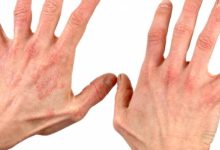Psoriasis is a chronic autoimmune condition that primarily affects the skin, leading to the rapid accumulation of skin cells and the formation of thick, scaly plaques. This condition can vary greatly in its presentation and impact on individuals. Here is an in-depth examination of the changes and manifestations associated with psoriasis.
Overview of Psoriasis
Psoriasis is characterized by an accelerated growth cycle of skin cells, which results in the buildup of scaly, inflamed patches on the skin. These patches are often red or pink, covered with silvery scales, and can be itchy or painful. Psoriasis is considered an autoimmune disease, where the immune system mistakenly attacks healthy skin cells, leading to inflammation and excessive skin cell turnover.
Types of Psoriasis
There are several types of psoriasis, each presenting with different characteristics:
-
Plaque Psoriasis: This is the most common type, affecting approximately 80-90% of people with psoriasis. It is characterized by dry, raised, red skin lesions (plaques) covered with silvery scales. These plaques commonly appear on the elbows, knees, lower back, and scalp.
-
Nail Psoriasis: This type affects the fingernails and toenails, leading to symptoms such as pitting (small depressions), discoloration, thickening, and separation of the nail from the nail bed.
-
Guttate Psoriasis: Often triggered by a bacterial infection such as strep throat, guttate psoriasis appears as small, drop-shaped, scaling lesions, primarily on the trunk, arms, legs, and scalp. It is more common in children and young adults.
-
Inverse Psoriasis: This form of psoriasis presents as bright red, shiny, and smooth lesions, typically found in skin folds, such as under the breasts, in the groin, or around the genitals and buttocks.
-
Pustular Psoriasis: Characterized by pustules (blisters of non-infectious pus) and red, inflamed skin, this type can cover large areas or be localized to specific parts of the body.
-
Erythrodermic Psoriasis: This is a rare but severe form of psoriasis that can cover large areas of the body with inflamed, peeling skin. It can lead to widespread redness and shedding of the skin and may be associated with systemic symptoms such as fever and chills.
Pathophysiology
The exact cause of psoriasis is not fully understood, but it is known to involve a combination of genetic and environmental factors. The condition is thought to be driven by an overactive immune response that leads to inflammation and rapid skin cell production. Normally, skin cells renew themselves over a period of about a month, but in psoriasis, this cycle is shortened to just a few days. This accelerated cell turnover causes the cells to accumulate on the skin’s surface, resulting in the formation of plaques.
Symptoms and Complications
The primary symptoms of psoriasis include:
- Plaques: Raised, red patches of skin covered with a silvery scale.
- Itching and Burning: A common symptom, often associated with the plaques.
- Dry, Cracked Skin: Areas of skin may crack and bleed.
- Joint Pain: Many individuals with psoriasis also experience psoriatic arthritis, which can cause pain, stiffness, and swelling in the joints.
- Nail Changes: Pitting, thickening, or separation of the nail from the nail bed.
Complications of psoriasis can include:
- Increased Risk of Cardiovascular Disease: Chronic inflammation associated with psoriasis may increase the risk of developing heart disease.
- Metabolic Syndrome: Psoriasis has been linked to an increased risk of obesity, diabetes, and high blood pressure.
- Depression and Anxiety: The visible nature of psoriasis and its impact on a person’s appearance and daily life can lead to significant psychological distress.
Triggers and Risk Factors
Several factors can trigger or exacerbate psoriasis symptoms:
- Infections: Streptococcal throat infections and other infections can trigger guttate psoriasis.
- Stress: Emotional stress is a known trigger for psoriasis flare-ups.
- Skin Injury: Trauma to the skin, such as cuts, burns, or insect bites, can lead to a psoriasis flare known as the Koebner phenomenon.
- Medications: Certain drugs, including lithium, antimalarials, and beta-blockers, can trigger or worsen psoriasis.
- Alcohol and Smoking: Both can exacerbate the condition and interfere with treatment.
Diagnosis
Psoriasis is typically diagnosed based on the appearance of the skin and medical history. A dermatologist may perform a physical examination and take a biopsy of the skin to confirm the diagnosis. The biopsy helps to rule out other conditions that may present with similar symptoms.
Treatment Options
There is no cure for psoriasis, but various treatments can help manage the symptoms:
-
Topical Treatments: These are applied directly to the skin and include corticosteroids, vitamin D analogues, tar preparations, and calcineurin inhibitors.
-
Phototherapy: This treatment involves exposing the skin to ultraviolet light under medical supervision. It can be effective for moderate to severe psoriasis.
-
Systemic Medications: These are oral or injected medications that work throughout the body. Examples include methotrexate, cyclosporine, and acitretin. Biologic drugs, such as TNF-alpha inhibitors and IL-17 inhibitors, are also used for severe cases.
-
Lifestyle and Home Remedies: Managing stress, avoiding triggers, and using moisturizers can help alleviate symptoms. Maintaining a healthy lifestyle with a balanced diet and regular exercise is also beneficial.
-
Alternative Therapies: Some people find relief with alternative treatments such as herbal remedies or dietary changes, although these should be used with caution and ideally under the guidance of a healthcare professional.
Living with Psoriasis
Living with psoriasis requires ongoing management and adaptation. Patients are encouraged to work closely with their healthcare providers to develop a personalized treatment plan. Support groups and counseling can also help individuals cope with the emotional and social aspects of the condition.
In conclusion, psoriasis is a complex and multifaceted condition with a range of manifestations and impacts on those affected. While there is no cure, advancements in treatment and a comprehensive approach to management can significantly improve quality of life for individuals living with psoriasis.

